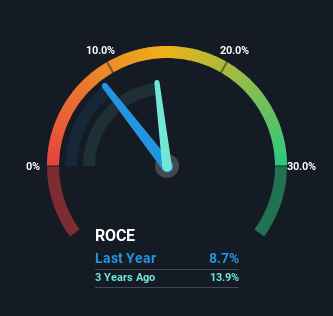- Japan
- /
- Personal Products
- /
- TSE:4452
Investors Could Be Concerned With Kao's (TSE:4452) Returns On Capital

If you're looking at a mature business that's past the growth phase, what are some of the underlying trends that pop up? More often than not, we'll see a declining return on capital employed (ROCE) and a declining amount of capital employed. This combination can tell you that not only is the company investing less, it's earning less on what it does invest. In light of that, from a first glance at Kao (TSE:4452), we've spotted some signs that it could be struggling, so let's investigate.
What Is Return On Capital Employed (ROCE)?
If you haven't worked with ROCE before, it measures the 'return' (pre-tax profit) a company generates from capital employed in its business. The formula for this calculation on Kao is:
Return on Capital Employed = Earnings Before Interest and Tax (EBIT) ÷ (Total Assets - Current Liabilities)
0.087 = JP¥115b ÷ (JP¥1.8t - JP¥451b) (Based on the trailing twelve months to March 2024).
So, Kao has an ROCE of 8.7%. On its own that's a low return on capital but it's in line with the industry's average returns of 8.7%.
See our latest analysis for Kao

Above you can see how the current ROCE for Kao compares to its prior returns on capital, but there's only so much you can tell from the past. If you'd like to see what analysts are forecasting going forward, you should check out our free analyst report for Kao .
How Are Returns Trending?
We are a bit worried about the trend of returns on capital at Kao. To be more specific, the ROCE was 18% five years ago, but since then it has dropped noticeably. Meanwhile, capital employed in the business has stayed roughly the flat over the period. Companies that exhibit these attributes tend to not be shrinking, but they can be mature and facing pressure on their margins from competition. So because these trends aren't typically conducive to creating a multi-bagger, we wouldn't hold our breath on Kao becoming one if things continue as they have.
The Key Takeaway
In summary, it's unfortunate that Kao is generating lower returns from the same amount of capital. And long term shareholders have watched their investments stay flat over the last five years. With underlying trends that aren't great in these areas, we'd consider looking elsewhere.
One more thing, we've spotted 2 warning signs facing Kao that you might find interesting.
While Kao may not currently earn the highest returns, we've compiled a list of companies that currently earn more than 25% return on equity. Check out this free list here.
Valuation is complex, but we're here to simplify it.
Discover if Kao might be undervalued or overvalued with our detailed analysis, featuring fair value estimates, potential risks, dividends, insider trades, and its financial condition.
Access Free AnalysisHave feedback on this article? Concerned about the content? Get in touch with us directly. Alternatively, email editorial-team (at) simplywallst.com.
This article by Simply Wall St is general in nature. We provide commentary based on historical data and analyst forecasts only using an unbiased methodology and our articles are not intended to be financial advice. It does not constitute a recommendation to buy or sell any stock, and does not take account of your objectives, or your financial situation. We aim to bring you long-term focused analysis driven by fundamental data. Note that our analysis may not factor in the latest price-sensitive company announcements or qualitative material. Simply Wall St has no position in any stocks mentioned.
About TSE:4452
Kao
Develops and sells hygiene and living care, health and beauty care, life care, cosmetics, and chemical products.
Flawless balance sheet established dividend payer.
Similar Companies
Market Insights
Community Narratives



